- Navigator
- South
- Featured Indicator
- State
- Strategic Planning & Doing
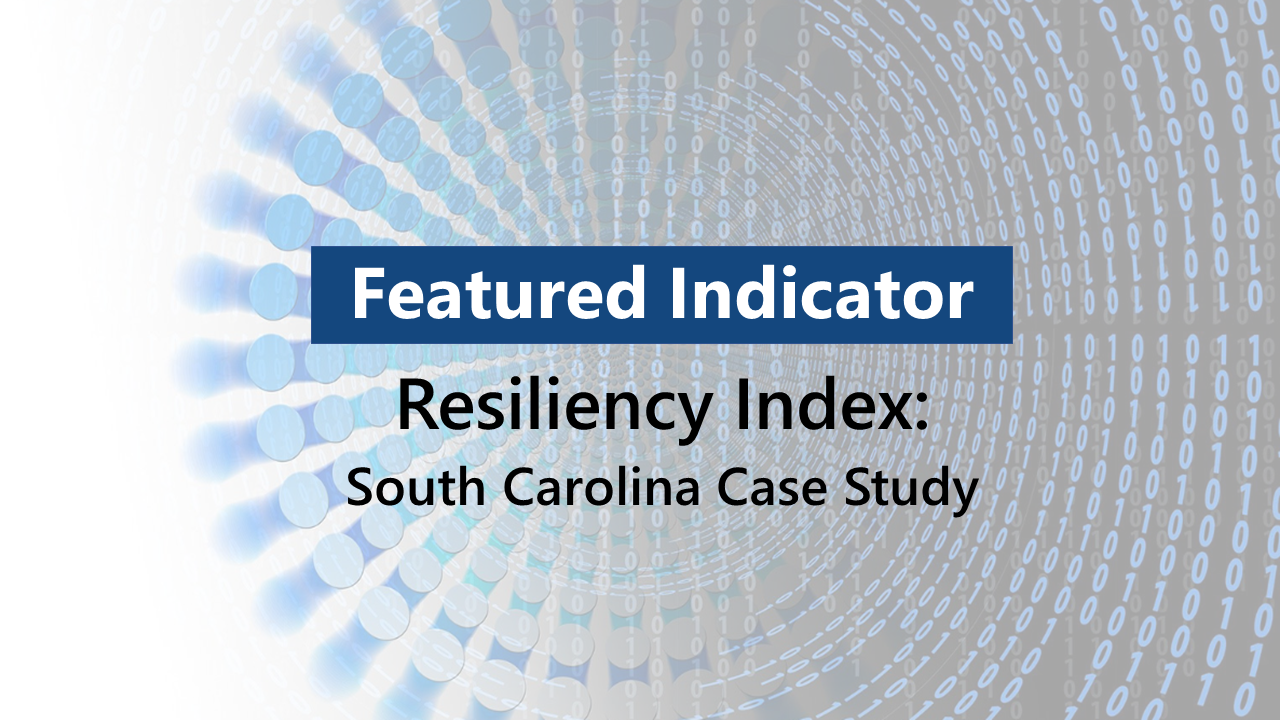
The University of South Carolina’s Hazards and Vulnerability Research Institute has developed a model of measuring community resiliency in South Carolina as part of its Baseline Resilience Indicators for Communities (BRIC). Here at Camoin Associates, we like to incorporate this data into strategic plans and other resilience-focused work. County-level data is available for two time periods (2010 and 2015) and can be downloaded directly from the University of South Carolina or accessed through PolicyMap.
The data includes an overall resilience score, which is the sum of scores in six subcategories: social, economic, infrastructural, community capital, institutional, and environmental resilience. Components of these categories are listed below:
- Social: absolute difference between percent population over age 25 with college education and percent population over age 25 with less than high school education (inverted); percent of population below age 65; percent of households with at least one vehicle; percent of households with telephone service available; percent of population proficient in English; percent of population without sensory, physical, or mental disability; percent of population under age 65 with health insurance; psychosocial support facilities per 10,000 persons; food security rate; and physicians per 10,000 persons.
- Economic: owner-occupied housing units; labor force employed; gini coefficient; percent of employees not in farming, fishing, forestry, extractive industry, or tourism; absolute difference between male and female median income; ratio of large to small businesses; large retail stores per 10,000 persons; and percent of labor force employed by federal government.
- Infrastructural: percent of housing units not mobile homes; percent of vacant housing units that are for rent; number of hospital beds per 10,000 persons; major road egress points per 10,000 persons; percent of housing units built prior to 1970 or after 2000; number of hotels/motels per 10,000 persons; number of public schools per 10,000 persons; rail miles per square mile; and percent of population with access to broadband internet service.
- Community Capital: percent of population not foreign-born persons who came to U.S. within previous five years; percent pf population born in state of current residence; percent of voting age population participating in recent election; number of people affiliated with a religious organization per 10,000 persons; number pf civic organizations per 10,000 persons; number of Red Cross volunteers per 10,000 persons; and number of Red Cross training workshop participants per 10,000 persons.
- Institutional: ten-year average per capita spending for mitigation projects; percent of housing units covered by National Flood Insurance Program; distance from county seat to state capital (inverted); distance from county seat to nearest county seat within a Metropolitan Statistical Area (inverted); number of governments and special districts per 10,000 persons (inverted); number of Presidential Disaster Declarations divided by number of loss-causing hazard events for ten year period; percent of population in communities covered by Citizen Corps programs; population change over previous five-year period (inverted); percent of population within ten miles of nuclear power plant; and number of crop insurance policies per square mile.
- Environmental: number of farms marketing products through Community Supported Agriculture per 10,000 persons; percent of land in wetlands; megawatt hours per energy consumer (inverted); average percent perviousness; and Water Supply Stress Index (inverted).
What is the data telling us?
Using South Carolina as an example, we took a look at the data to understand which counties are outperforming on these measures of resiliency, compared to the state. Resilience scores in each subcategory can range from 0 to 1, where higher score correspond to higher resilience. The overall resilience score, shown in the map below, is the sum of the scores in all subcategories.
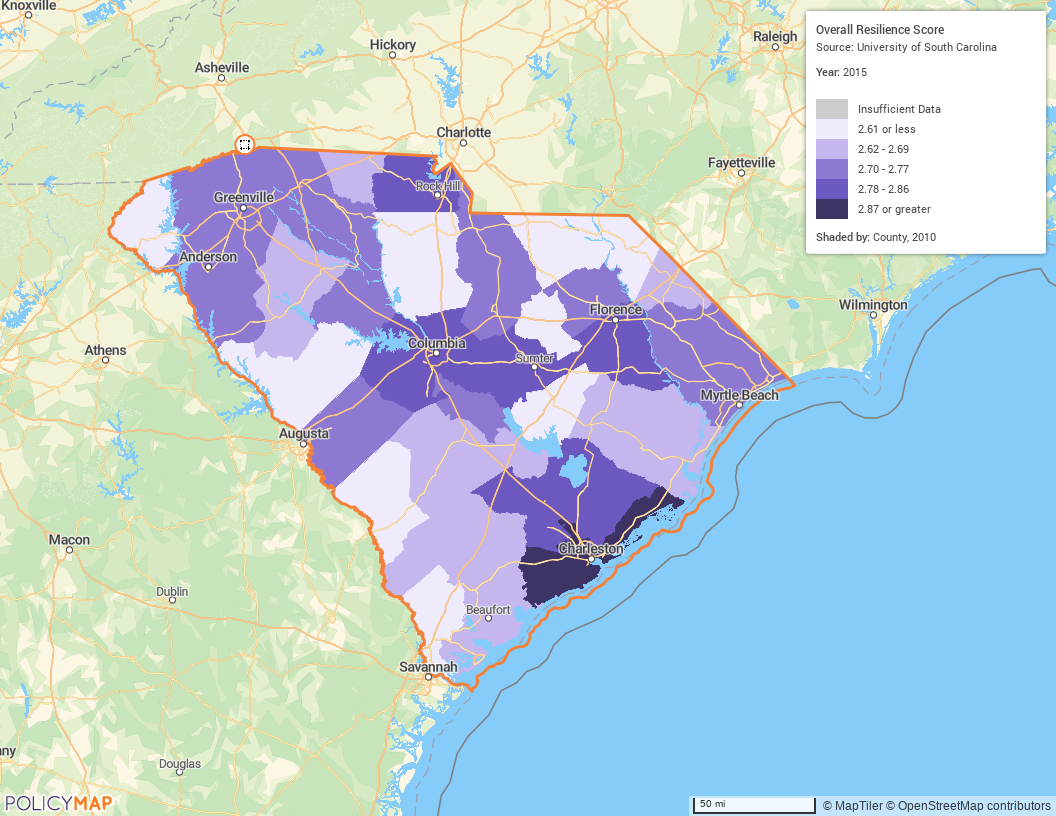
Within South Carolina, Charleston County has the highest overall resilience score of 2.91. This is followed by Florence and Richland Counties, with scores of 2.85. The average overall resilience score of all South Carolina counties is 2.69.
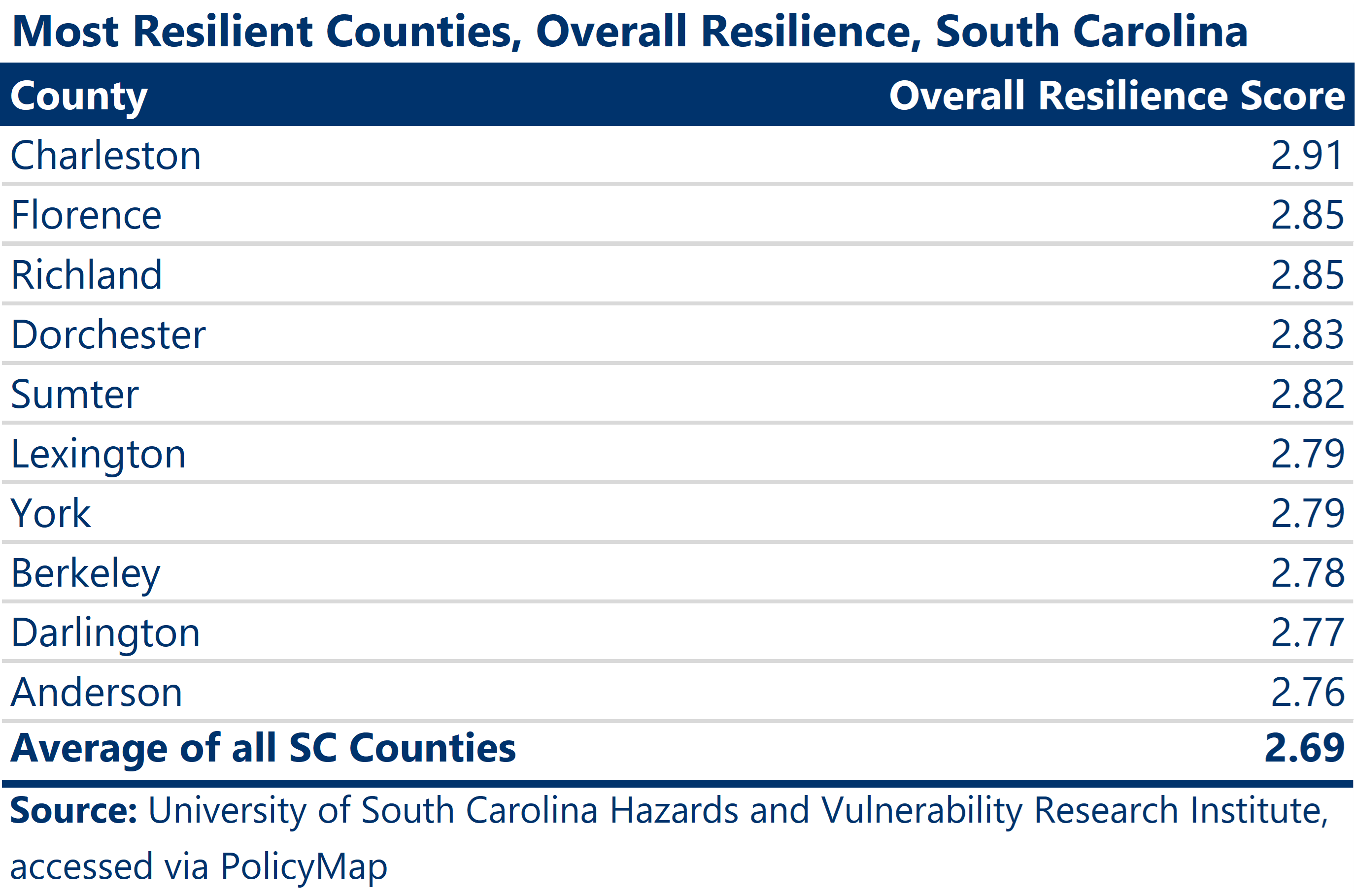
Charleston County, the county with the best overall resilience score ranks highest in the infrastructural, institutional, and environmental resiliency categories (second out of 46 counties). The rankings for the other top 10 most resilient counties by category are included in the below table.
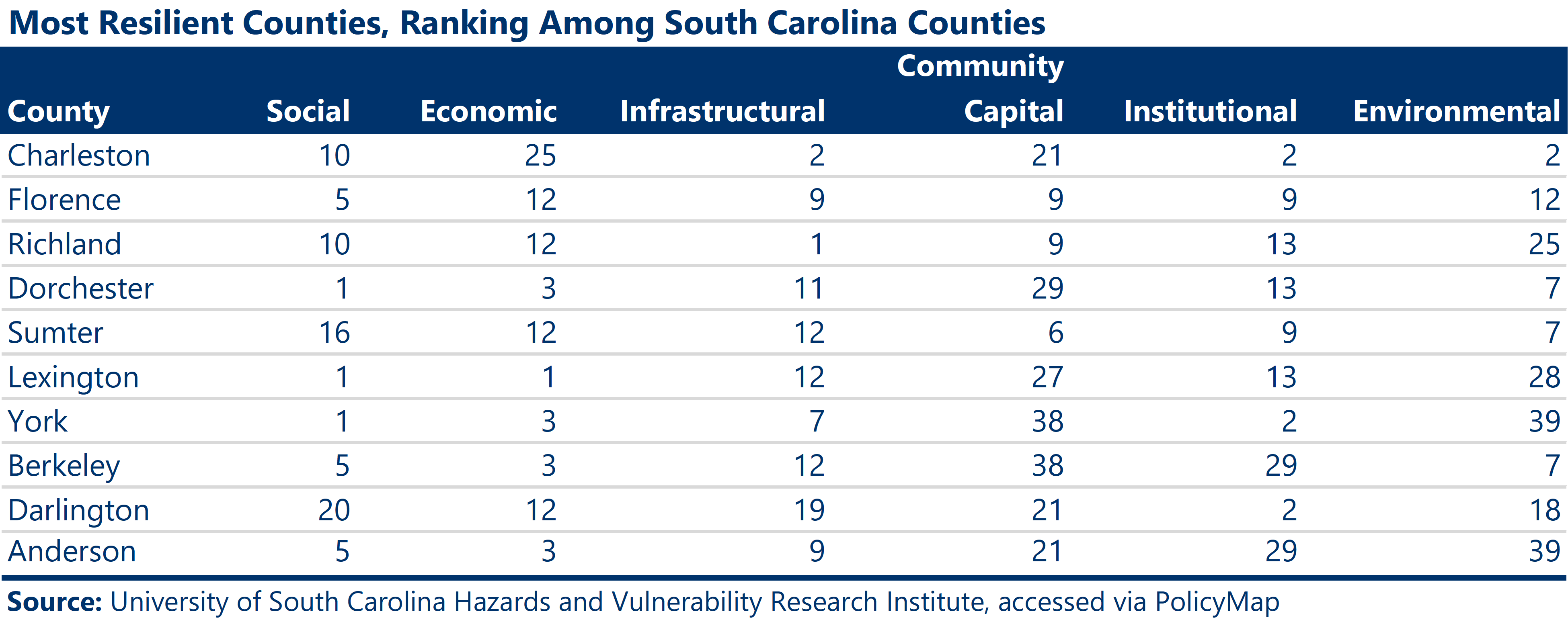
Different counties within the state have different resiliency strengths. Beaufort County, for example, is the top ranked county in terms of institutional and environmental resiliency. Dorchester, Lexington, York, and Pickens counties are tied for the highest social resiliency scores, while Lexington County has the highest economic resiliency score, Richland County has the highest infrastructural resiliency score, and Abbeville County has the highest community capital resiliency score.
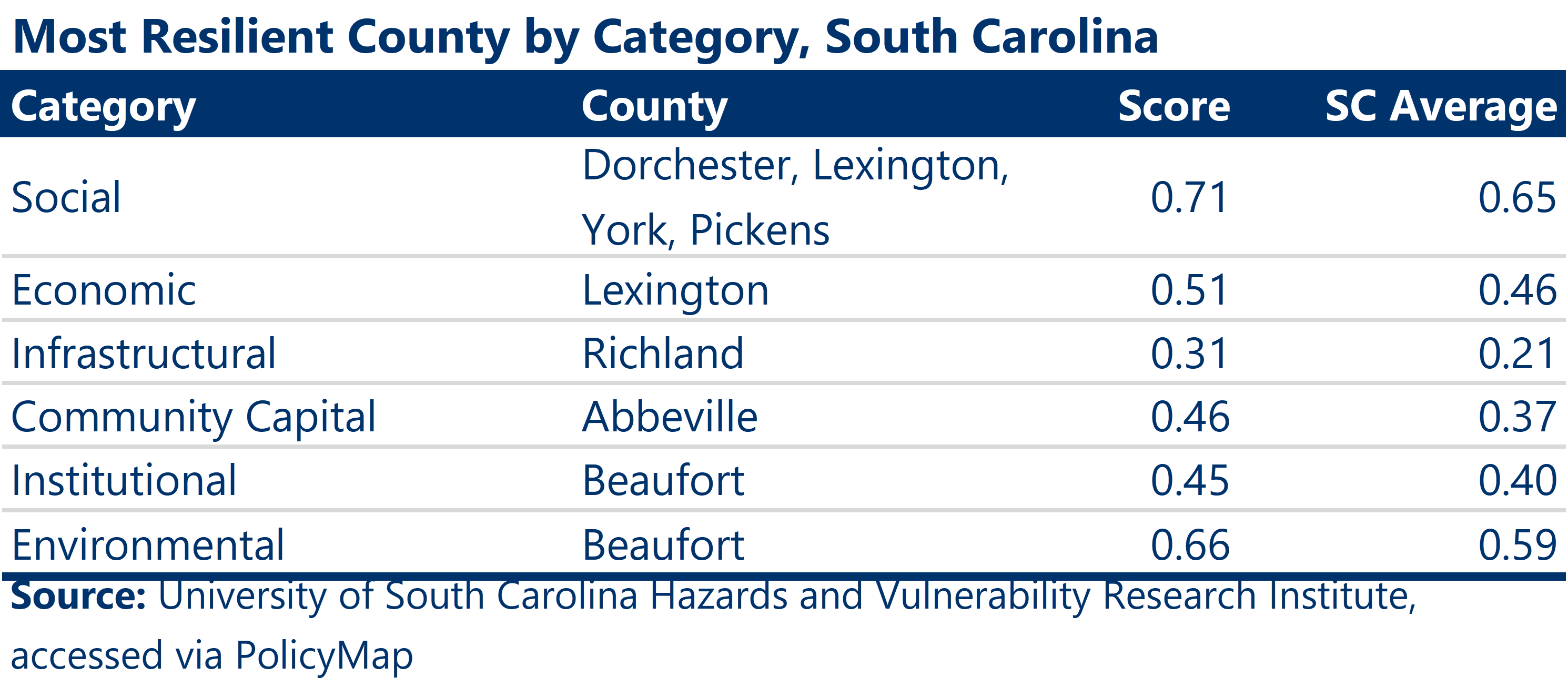
Why is this important?
According to Camoin Associates’ own Dan Gundersen, “A community’s economic resiliency is determined by the ability of its leaders to anticipate these risks and evaluate the impacts, plus their capacity to make sound decisions involving diverse inputs, and their willingness to take proactive (and possible unpopular) actions to minimize such risks.” Key to this is understanding where your community falls currently in terms of economic resiliency and where investments should be made to improve resiliency. This data, along with other measures such as the Hachman Index, can help communities move towards this understanding.
For more information on resiliency, check out Dan Gundersen’s article, “The Secret to Economic Resiliency (It’s Not What You Think)” or visit Camoin Associates’ Resiliency Resources webpage.





